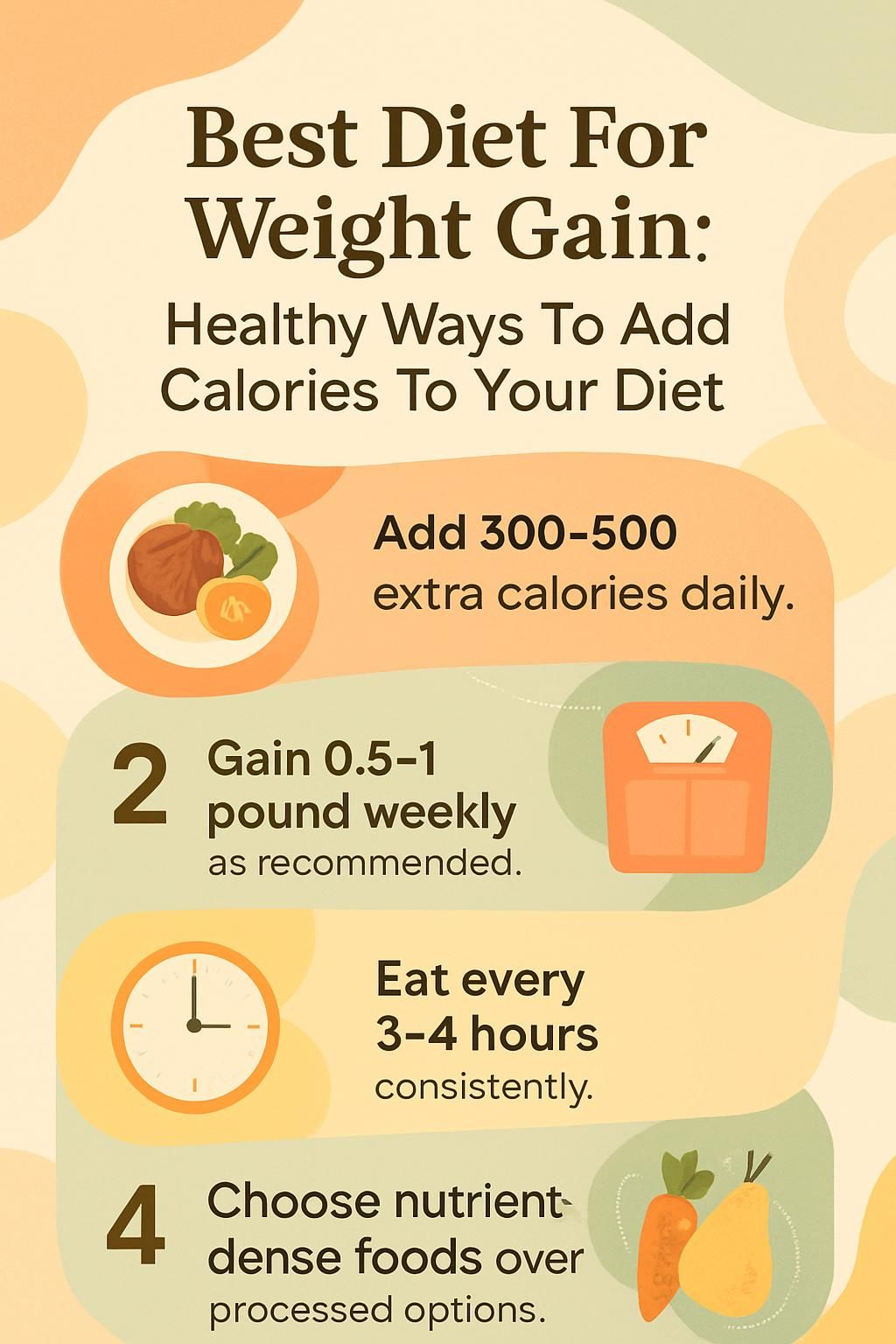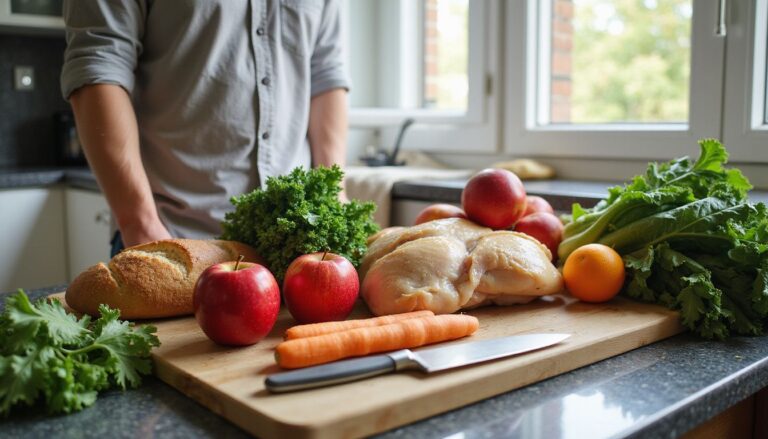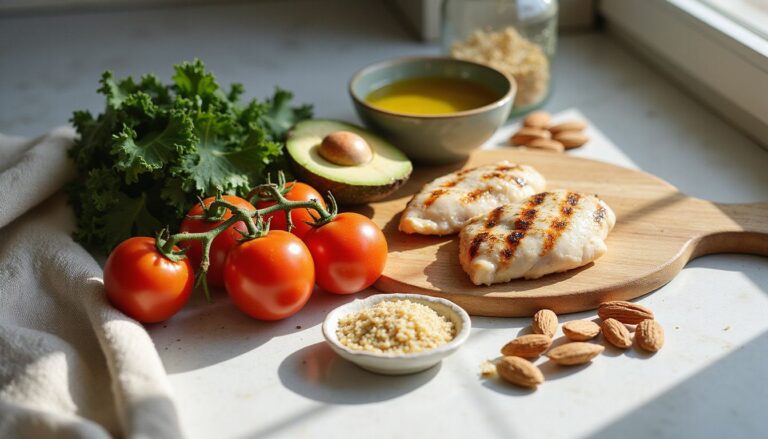Best Diet For Weight Gain: Healthy Ways To Add Calories To Your Diet
Our Nutrition Assistant AI Suite will transform your body. You will lose fat, get toned, and build muscle. Gain confidence and optimal health.
Trying to gain weight can feel as hard as losing it. Your body needs steady extra energy, plus the right mix of protein, fats, and carbs. With a smart plan, you can add calories to your diet without relying on junk food or large portions that make you uncomfortable.
This guide shares healthy ways to increase calorie intake, including practical tips, simple meal ideas, and snacks that help you reach a healthy weight. It is educational, not medical advice. If you have a health condition or take medications, speak with a health care provider or a registered dietitian.
Key Takeaways
- Add 300 to 500 calories per day to gain about 0.5 to 1 pound each week, based on guidance from the Academy of Nutrition and Dietetics.
- Pick nutrient-dense foods such as nuts, eggs, full-fat dairy, avocado, oily fish, and whole grains. Limit high-sugar snacks and ultra-processed foods.
- Track weight weekly. If you are not gaining 0.5 to 1 pound each week, raise daily calories in small steps, as experts like Michelle Cardel, PhD suggest.
- Eat every three to four hours. Aim for three meals plus two or three snacks to stay in a calorie surplus.
- Limit refined sugars, fried foods, and processed meats. These foods raise heart risk and do little for muscle development.

Key Aspects of Weight Gain

Healthy weight gain happens when you eat more energy than you burn, and your diet supports muscle growth. Small changes add up, especially if appetite feels low.
What challenges do people face when trying to gain weight?
Many people have a small appetite or feel full quickly. That makes larger portions tough. Some live with fast metabolism or digestive issues that burn through energy fast. Others worry about picking healthy foods that are high in calories.
Cost and planning can be hard, too. Foods like nut butter, avocado, cheese, and Greek yogurt help, but they may need prep time. A simple fix is to add one extra snack or smoothie between meals. This can raise calories without making meals feel huge.
What are healthy strategies for gaining weight?
Focus on nutrient-dense foods at every meal and snack. Build plates with complex carbs, protein, and healthy fat. Add easy energy boosts, for example a tablespoon of olive oil on vegetables or a dollop of sour cream on mashed potatoes.
- Complex carbs: quinoa, wild rice, oats, whole-grain toast.
- Protein: eggs, lentils, tuna, salmon, Greek yogurt, dry milk powder in smoothies.
- Healthy fats: avocado, nuts, nut butters, olive oil.
Eat smaller meals more often if large portions feel uncomfortable. Try calorie-rich shakes made with whey protein or a smoothie with avocado and peanut butter. A registered dietitian can help you set a plan that matches your needs and goals.
“Adding just 500 calories per day may lead to about one pound of weight gain per week.”
Weigh yourself weekly to check progress. If weight stalls, increase daily calories slightly and review your routine. Aim for a plan that supports a healthy BMI and muscle gain, not excess saturated fat from processed foods.
How to Calculate Your Calorie Needs
Estimating your daily needs helps you add the right amount of extra calories. A clear target makes tracking easier and more accurate.
How do I use a calorie calculator for weight gain?
Enter your age, sex, weight, height, and activity level into a calculator. You will get a baseline for maintenance calories, which is the energy you need to keep your current weight.
For weight gain, add 300 to 500 calories per day to that number. Log your meals and snacks, including condiments and drinks. Adjust weekly. If you are not gaining about 0.5 to 1 pound per week, add a little more food. If you have a chronic condition or a special diet, consult a health care provider or dietitian before making big changes.
How many extra calories should I eat for gradual weight gain?
A surplus of about 300 to 500 calories per day supports steady progress. Research from professional groups suggests this pace helps you gain around 0.5 to 1 pound per week.
Pick high calorie foods that also carry nutrients, such as nut butters, healthy oils, whole eggs, and dairy products. If you lift weights and raise protein intake, more of that gain can be muscle instead of fat.
Nutrient-Dense Foods for Weight Gain
Nutrient-dense foods pack more protein and calories into each serving. They help you meet goals without oversized portions.
What are the best protein sources for weight gain?
Protein helps repair and build muscle. Good options include:
- Lean meats: chicken breast, turkey, lean beef, about 22 to 26 grams of protein per 3 to 4 ounces.
- Fish: salmon and tuna, at least 20 grams per 4 ounces plus heart-healthy fats.
- Eggs: about 6 grams of protein each, with all essential amino acids.
- Dairy: Greek yogurt, cottage cheese, and whole milk add protein and calories.
- Plant-based: tofu, lentils, beans, quinoa, chia pudding, peanut butter sandwiches.
Combine plant and animal proteins as needed. The mix supports muscle growth and adds variety to meals and snacks.
Which healthy fats should I include in my diet?
Healthy fats raise calorie intake fast and support hormone health. Choose avocados, olive oil, nuts, and nut butters such as almond or peanut. Add fatty fish like salmon, tuna, and mackerel for omega-3 fats that support heart and brain health.
Practical ideas:
- Blend chia seeds or flaxseeds into oatmeal or smoothies.
- Snack on walnuts, almonds, or pistachios. One ounce of walnuts has about 185 calories.
- Use olive oil as a cooking fat and salad dressing.
I often drizzle extra virgin olive oil on soups. It adds calories and flavor without making the portion feel bigger.
What complex carbohydrates provide sustained energy?
Complex carbs provide slow, steady energy and support training. Pick brown rice, quinoa, oats, and whole wheat bread. Try starchy vegetables such as sweet potatoes, corn, peas, and squash.
Beans and lentils add fiber and protein to dishes like chili or casseroles. Oatmeal with granola or whole-grain toast at breakfast can make meals more filling and steady your blood sugar.
Essential High-Calorie Foods for Your Diet
Some foods deliver many calories in small portions. These are useful when appetite is small or time is short.
Why are nuts and nut butters good for weight gain?
Nuts and nut butters are calorie dense and easy to use. Two tablespoons of peanut butter provide about 190 calories. A small handful of mixed nuts gives around 170 to 200 calories, plus protein and healthy fats.
Spread nut butter on toast or apples. Add chopped nuts to yogurt or oatmeal. These choices raise calories quickly without relying on sweets.
How do avocados help increase calorie intake?
Avocados supply monounsaturated fat, which supports nutrient absorption. One medium avocado has around 250 to 300 calories. The creamy texture blends well into many meals.
Add sliced avocado to toast, tacos, or sushi. Blend half an avocado into a smoothie or mash it into grain bowls. Many people find it easy to eat often, which helps raise total intake.
Are whole eggs beneficial for gaining weight?
Whole eggs are an efficient package of protein and fat. Each large egg has about 70 calories, 6 grams of protein, and almost 5 grams of fat. The amino acid leucine supports muscle building during strength training.
Enjoy eggs scrambled with cheese, on toast with avocado, or folded into fried rice. Pairing eggs with other calorie-dense foods makes each meal work harder for your weight gain goals.
What dairy products are best for adding calories?
Choose full-fat dairy to add energy and key nutrients like calcium. Examples include:
- Whole milk: about 149 calories per cup.
- Full-fat Greek yogurt: roughly 190 calories per cup.
- Heavy cream: nearly 400 calories per cup.
- Cheese: cheddar has about 115 calories per ounce.
Stir cream into soups or coffee, melt cheese over eggs or vegetables, and use whole milk in smoothies or oatmeal.
Which fatty fish options support weight gain?
Fatty fish add calories and omega-3 fats that support heart health. Try salmon, mackerel, sardines, and herring. A 6-ounce serving of cooked salmon provides nearly 350 calories and about 21 grams of fat. Mackerel can provide around 400 calories per serving.
Use tuna packed in oil to enrich salads or sandwiches. Sardines offer vitamin D along with protein and healthy fats.
Meal Planning for Effective Weight Gain
A simple plan helps you eat enough food day after day. Think in building blocks, then repeat meals you enjoy.
What are some high-calorie breakfast ideas?
Start strong to set the pace for the day. Easy options include:
- Whole-grain toast with peanut or almond butter, sliced banana, and a drizzle of honey.
- Scrambled eggs with cheese and avocado, plus Greek yogurt mixed with granola.
- A smoothie with oats, milk or a milk substitute, protein powder, and berries.
- Oatmeal topped with chopped nuts and dried fruit.
My go-to breakfast is two fried eggs on sourdough with a glass of fortified orange juice. It keeps energy steady through busy mornings.
What lunch and dinner meals promote weight gain?
Build meals around protein, carbs, and healthy fats. Here are balanced options:
- Grilled chicken with brown rice and roasted vegetables. Finish with olive oil for extra calories.
- Salmon with mashed potatoes and sautéed spinach. Add avocado slices on the side.
- Hearty chili with beans, ground turkey or beef, and cheese.
- Pasta with a creamy sauce, chicken, and chopped nuts for crunch and calories.
Round out meals with Greek yogurt, cottage cheese, or whole-grain rolls. These sides add calories and protein with little effort.
Which snacks are best for adding calories?
Snack choices can make or break your calorie goals. Try these portable options:
- Trail mix with nuts and dried fruit.
- Whole-milk Greek yogurt with granola.
- Cheese cubes with whole-grain crackers.
- Nut butter on toast or apple slices.
- Energy bars made with oats, seeds, and nut butter.
Pair snacks for more impact. For example, yogurt plus mixed nuts gives protein, fat, and carbs in one quick break.
Boosting Calorie Intake with Smoothies and Shakes
Smoothies and shakes are an easy way to drink your calories, which helps when appetite is low.
How can I make homemade protein smoothies for weight gain?
Start with a protein base. Blend Greek yogurt, milk, or a milk alternative with your favorite protein powder. Then add calorie boosters such as nut butter, avocado, banana, or oats.
For flavor and extra energy, use honey, cocoa powder, or frozen fruit. Seeds like chia or ground flax add fiber and omega-3s. One shake can reach 400 to 600 calories, depending on ingredients and portion size.
Quick recipe: blend 1 cup whole milk, 1/2 cup Greek yogurt, 2 tablespoons peanut butter, 1 banana, 1 scoop whey protein, and ice cubes.
What ingredients increase the calorie content in shakes?
Use ingredients that add energy and texture without too much volume. Good choices include:
- Whole milk, Greek yogurt, or heavy cream for calories and protein.
- Nut butters, avocado, coconut milk, or canned coconut cream for healthy fats.
- Oats, cooked rice, or a slice of toast for complex carbs.
- Protein powder for protein and extra calories.
- Honey, maple syrup, or dates for sweetness and energy.
- Chia or flaxseed for fiber and healthy fats.
Blend with fruit juice or fortified plant milks instead of water if you need even more calories per serving.
Tips for Enhancing Calorie Intake
Routines matter. Small, consistent actions make it easier to stay in a calorie surplus.
How often should I eat to gain weight effectively?
Eat every three to four hours. Aim for three main meals plus two or three snacks each day. This schedule spreads calories across the day and helps you meet your targets.
Do not skip breakfast. A morning meal jumpstarts calorie intake. Setting phone reminders can help you keep snack times on track during busy days.
What calorie-rich toppings and ingredients boost meals?
Boost meals with toppings that add calories fast, without adding much volume:
- Nut butters, shredded cheese, or full-fat yogurt on toast, oatmeal, or pancakes.
- Avocado slices on eggs, salads, or sandwiches.
- Seeds such as chia, flax, or pumpkin on smoothies, soups, or cereals.
- Olive oil drizzled over vegetables, grains, or pasta.
- Eggs or smoked salmon added to salads and grain bowls.
If a clinician recommends it, use dietary supplements to fill gaps. Many people can meet needs with whole foods and thoughtful meal planning.
Which high-calorie drinks can support weight gain?
Drinks can raise calories with less fullness. Options include:
- Smoothies with Greek yogurt, nut butter, oats, and banana.
- Whole milk or chocolate milk, about 150 calories per cup for whole milk.
- Homemade protein shakes with oats, honey, or avocado.
- Milkshakes made with full-fat dairy or ice cream.
- 100 percent fruit juice and ready-to-drink meal shakes, 250 to 400 calories per serving.
Use drinks between meals or alongside snacks. Read labels to avoid high added sugar when choosing packaged options.
Combining Muscle Building with Weight Gain
Strength training helps your body use extra calories to build muscle, which supports a higher body weight over time.
How does strength training aid in gaining weight?
Resistance exercise creates tiny tears in muscle fibers. Your body repairs them, then the fibers grow stronger and larger. This process uses protein and energy from your diet.
Plan for a small calorie surplus, roughly 200 to 500 calories per day, to fuel growth. Include whole eggs, dairy, lean meats, and nut butters for quality protein and calories. Training two to three times per week works for many people.
What are the protein needs for muscle development?
Aim for 0.7 to 1.0 grams of protein per pound of body weight daily. This range supports repair and growth after workouts.
Spread protein across the day. Mix sources such as lean meats, eggs, dairy, beans, tofu, and seeds. Add Greek yogurt or cottage cheese to breakfast, and choose protein-rich snacks like trail mix or roasted chickpeas.
Avoiding Common Weight Gain Errors
A few habits can slow progress. Knowing what to limit helps you build a healthier plan.
Why should I avoid unhealthy, processed foods when gaining weight?
Ultra-processed foods often contain refined sugars, unhealthy fats, and additives. They may push fat gain without helping muscle growth. These foods usually lack important nutrients, including vitamins, minerals, and fiber.
Diets high in processed foods raise the risk of heart disease, type 2 diabetes, and high blood pressure. For example, high intake of trans fats can raise LDL cholesterol and lower HDL cholesterol [1]. Choose whole foods like nuts, avocados, eggs, dairy, and fatty fish to support healthy weight gain and reduce health risks.
[1] Harvard T.H. Chan School of Public Health: “Trans Fats.”
How can skipping meals affect weight gain progress?
Skipping meals drops your daily calories and may cause fatigue or muscle loss. It also makes workouts feel harder and recovery slower.
Regular meals keep energy steady and support digestion. They also make it easier to hit protein targets that protect lean mass.
How important is tracking my weight gain progress?
Tracking helps you see what works. Use a chart or app to log weekly weight. Slow, steady gains are the goal.
If weight does not rise by about 0.5 to 1 pound per week, increase calories slightly. Add a snack or enrich meals with nuts, dairy, or calorie-dense smoothies. If you take medicines or have medical needs, discuss any changes with your clinician.
Tailoring Weight Gain Strategies for Various Groups
Food choices vary by preference and activity level. You can reach goals with many eating styles.
What weight gain advice is best for vegetarians and vegans?
Plant-based eating can support healthy weight gain. Focus on calorie-dense choices and complete protein patterns.
- Energy foods: nuts, seeds, nut butters, avocados, coconut products, dried fruits, and whole grains.
- Protein sources: legumes like lentils and chickpeas, tofu, tempeh, soy milk, and fortified products.
- Smoothies: soy or oat milk with bananas, peanut butter, oats, and flaxseeds.
Snack often and cook with olive or coconut oil to raise calories. Pair legumes with grains to cover essential amino acids.
How should athletes approach weight gain differently?
Athletes need more calories and protein to support training and recovery. Target 1.2 to 2.0 grams of protein per kilogram of body weight. Build meals with whole grains, lean meats, dairy, nuts, seeds, and nutrient-rich smoothies.
Eat before and after practice. Track progress with performance markers, not just the scale. During track season, I gained faster by adding a chicken sandwich with avocado after evening practice instead of grabbing sugary snacks.
Identifying Foods to Minimize or Avoid
Some foods add calories but bring few nutrients. Limiting them supports better health while you gain weight.
Why should I limit refined sugars and sweets?
Refined sugars can cause blood sugar spikes and crashes. These swings leave you tired and hungry soon after eating. High sugar intake tends to add fat rather than support muscle growth.
Research links added sugars to heart disease, fatty liver, and type 2 diabetes. Swap candy and pastries for fruit, yogurt, or trail mix. These choices add calories and nutrients your body can use.
Which fried and heavily processed foods should be avoided?
Limit fries, fried chicken, chips, donuts, instant noodles, frozen pizzas, packaged pastries, and many fast food items. These foods are high in unhealthy fats, sodium, and additives.
Processed meats like bacon, sausages, hot dogs, and some deli slices often contain preservatives such as nitrates. High intake is linked to long-term health risks. Whole or minimally processed foods help you gain weight with more vitamins, minerals, and protein per bite.
Maintaining Consistency and Tracking Success
Consistency turns a plan into progress. Tracking gives feedback so you can keep moving forward.
How do I effectively track my calories and weight?
Use a food diary or an app to log meals and snacks. Many apps allow barcode scans and food searches, which speeds up tracking.
Weigh yourself at the same time each morning to reduce day-to-day swings from meals and hydration. Compare your intake to your target, usually 300 to 500 extra calories above maintenance. Review your data weekly and adjust as needed.
What are realistic goals for weight gain?
A healthy pace is 0.5 to 1 pound per week. That usually means a surplus of 250 to 500 calories per day. Slow gain allows your body to add more muscle and less fat.
Combine strength training with nutrient-dense meals to improve body composition. For most adults, gaining 5 to 10 pounds over two to three months is a reasonable target.
FAQs
These quick answers address common questions about weight gain and nutrition.
How fast should I expect to gain weight?
Plan for about 0.5 to 1 pound per week. That pace usually requires a daily surplus of 300 to 500 calories. Faster gains often lead to more fat than muscle. Pair your plan with strength training for better results.
Can I gain weight without eating meat?
Yes. Build meals with beans, lentils, tofu, tempeh, quinoa, nuts, and seeds. Add calorie-dense foods like nut butter, avocado, and whole grains. If you eat dairy, include cheese and Greek yogurt for extra protein and calories.
As a vegetarian college athlete, I made progress after adding peanut butter toast and smoothies with oats, soy milk, bananas, and flaxseed.
What are recommended snacks for weight gain?
Great options include nut butter on whole-grain bread, trail mix with mixed nuts and dried fruit, and cheese with crackers. Greek yogurt topped with granola adds protein and fat.
Other ideas: avocado toast, hummus with pita chips, hard-boiled eggs, or cottage cheese with pineapple. A smoothie made with whole milk, oats, peanut butter, banana, and whey protein often lands around 400 to 500 calories per serving.
Conclusion
Healthy weight gain takes steady habits and the right foods. Eat more often, favor nutrient-dense choices, and use smoothies, snacks, and toppings to add calories to your diet. Combine this with strength training to support muscle growth.
Track your weight weekly and adjust in small steps. If you have medical needs or an underweight history, work with a dietitian or health care provider. With a clear plan and patient effort, you can gain weight safely and maintain results.
FAQs
1. What are healthy ways to add calories for weight gain?
Eating more nutrient-rich foods helps increase calorie intake safely. Choose whole grains, lean meats, nuts, seeds, and dairy products. Add olive oil or avocado to meals for extra energy without unhealthy fats.
2. How much protein should I eat when trying to gain weight?
Aim for 0.7 to 1 gram of protein per pound of body weight each day according to research from the National Institutes of Health. Protein supports muscle growth and repair during a higher-calorie diet.
3. Are there specific foods that help with healthy weight gain?
Yes; peanut butter, eggs, cheese, salmon, potatoes, oats, and dried fruit provide dense nutrition and calories in small servings according to data from the USDA Food Database.
4. Can exercise support my efforts while following a high-calorie diet?
Strength training builds muscle mass as you eat more calories; this approach prevents excess fat storage and improves overall health outcomes based on studies published in the Journal of Nutrition & Metabolism.
Summary: Eating balanced meals with added healthy fats boosts calorie intake for safe weight gain. Including enough protein aids muscle development while strength training ensures gains come mostly from lean tissue rather than fat stores.
Personal Experience: When I aimed to build strength last year after an illness caused unintentional loss of pounds I focused on eating larger portions at every meal using nut butters whole milk yogurt and cooked grains like rice or quinoa as staples which helped me regain both energy levels and physical stamina within three months.
Data Table:
Food Item | Calories (per serving) | Protein (g)
——————|———————–|————
Peanut Butter | 190 | 8
Whole Milk Yogurt | 150 | 6
Cooked Quinoa | 220 | 8
Salmon| 200 | 22
These choices offer concentrated nutrients making them effective options for anyone seeking steady progress toward their target body weight through dietary changes supported by evidence-based recommendations.







